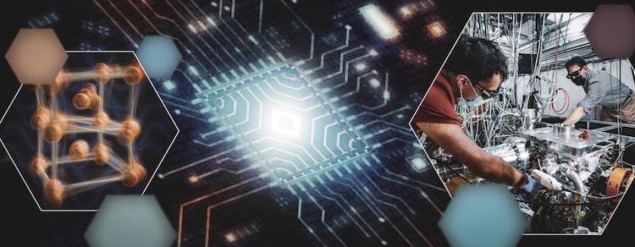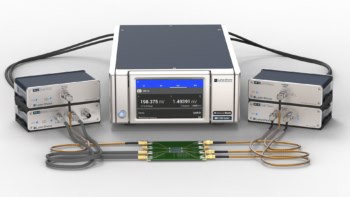
A new ultrafast imaging technique that captures the motion of atoms in nanoscale electronic devices has revealed the existence of a short-lived electronic state that could make it possible to develop faster and more energy-efficient computers. The imaging technique, which involves switching the devices on and off while taking snapshots of them with an electron diffraction camera, could also help researchers probe the limits of electronic switching.
“In general, we know very little about the intermediate phases materials pass through during electronic switching operations,” explains Aditya Sood, a postdoctoral research at the US Department of Energy’s SLAC National Accelerator Laboratory and lead author of a paper in Science about the new method. “Our technique allows for a new way to visualize this process and therefore address what is arguably one of the most important questions at the heart of computing – that is, what are the fundamental limits of electronic switches in terms of speed and energy consumption?”
Ultrafast electron diffraction camera
Sood and colleagues at SLAC, Stanford University, Hewlett Packard Labs, Pennsylvania State University and Purdue University chose to study devices made from vanadium dioxide (VO2) because the material is known to transition between insulating and electrically conducting states near room temperature. It thus shows promise as a switch, but the exact pathway underlying electric field-induced switching in VO2 has long been a mystery, Sood tells Physics World.
To take snapshots of VO2’s atomic structure, the team used periodic voltage pulses to switch an electronic device made from the material on and off. The researchers synchronized the timing of these voltage pulses with the high-energy electron pulses produced by SLAC’s ultrafast electron diffraction (UED) camera. “Each time a voltage pulse excited the sample, it was followed by an electron pulse with a delay that we could tune,” Sood explains. “By repeating this process many times and changing the delay each time, we created a stop-motion movie of the atoms moving in response to the voltage pulse.”
This is the first time that anyone has used UED, which detects tiny atomic movements in a material by scattering a high-energy beam of electrons off a sample, to observe an electronic device during operation. “We started thinking about this subject three years ago and soon realized that existing techniques were simply not fast enough,” says Aaron Lindenberg, a professor of materials science and engineering at Stanford and the study’s senior author. “So we decided to construct our own.”
Atomic structure remains unchanged
Using this new technique, the team discovered that applying fast electrical pulses to VO2 drives the material into an electronic state that does not usually exist. This state, which lasts for only microseconds, appears when the material transitions from being insulating to conducting. Unusually, the atomic structure of this intermediate, metastable phase remains the same throughout the transition. SLAC team member Xiaozhe Shen explains that this is important because the insulating and conducting states of the material have slightly different atomic arrangements, and it normally takes energy to switch from one to another. However, when the transition takes place through the intermediate state, the switch can take place without any change to the atomic arrangement.

5G switching gets a 2D boost
Working with theorists Yin Shi and Long-Qing Chen at Penn State, the researchers realized that the electrically-driven isostructural state is likely stabilized by interfacial interactions between the equilibrium phases, as well as subtle inhomogeneities (disorder) in the material at the nanoscale. They are now studying ways of engineering defects in materials to make this new state more stable and longer lasting.
Ultimately, the research could make it possible to construct devices in which electronic switching occurs without any atomic motion, which would allow the switches to operate faster and use less energy. The team’s new imaging technique also has wider applications: Lindenberg points out that understanding what happens on an atomic scale at the very moment a material is shocked with an electrical pulse is important for several technologies, including batteries in electric vehicles and transistors in smartphones.



